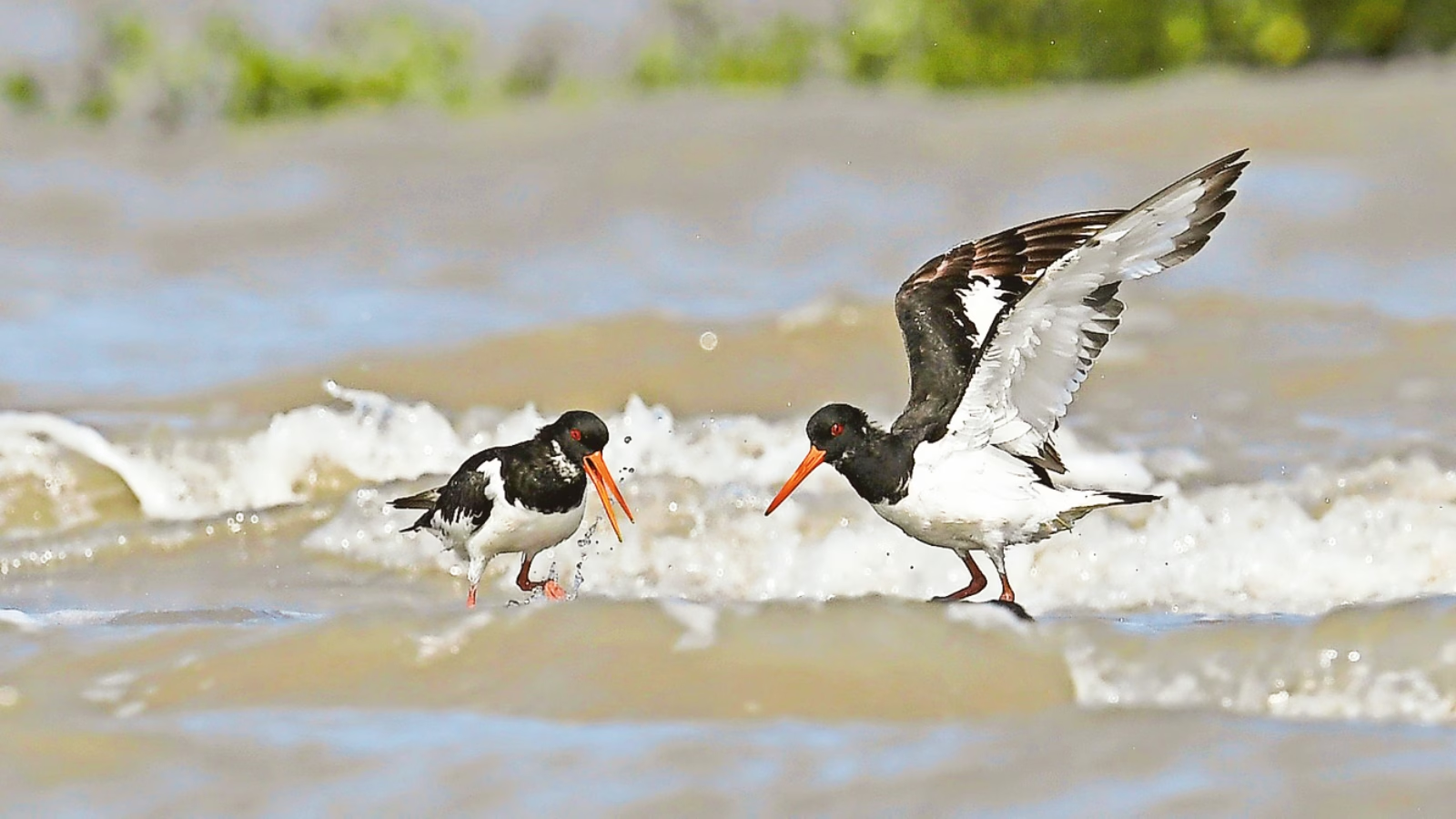- Courses
- GS Full Course 1 Year
- GS Full Course 2 Year
- GS Full Course 3 Year
- GS Full Course Till Selection
- CSAT
- 5 LAYERED ARJUNA Mentorship
- Public Administration Optional
- Online Program
- GS Recorded Course
- NCERT Batch
- Polity Module Course
- Geography Module Course
- Economy Module Course
- AMAC Module Course
- Modern India, Post Independence & World History Module Course
- Environment Module Course
- Governance Module Course
- Science & Tech. Module Course
- International Relations and Internal Security Module Course
- Disaster Management Module Course
- Ethics Module Course
- Essay Module Course
- Current Affairs Module Course
- ABOUT US
- OUR TOPPERS
- TEST SERIES
- FREE STUDY MATERIAL
- VIDEOS
- CONTACT US
India’s First-Ever Coastal and Wader Bird Census
India’s First-Ever Coastal and Wader Bird Census

- From January 3 to 5, 2025, India conducted its first-ever census of coastal and wader birds at Gujarat’s Marine National Park in Jamnagar.
- This landmark event aimed to monitor bird populations, assess habitat health, and strengthen conservation efforts.
- The census saw the participation of over 100 bird watchers, covering key wetland areas along the coastline from Okha to Navlakhi.
What are Wader Birds?
Wader birds, also known as shorebirds or sandpipers, are typically found in coastal habitats, wetlands, and mudflats.
Characteristics of Wader Birds:
- Long legs for wading in shallow waters.
- Slender bodies adapted for quick movement.
- Long bills to forage for insects, worms, and small aquatic creatures.
There are approximately 210 species of waders, each adapted to different climatic zones and ecosystems. While many tropical wader species are resident, those from Arctic and temperate regions are highly migratory.
Diversity of Wader Birds
Wader birds are found across varied landscapes, from Arctic tundras to tropical wetlands.
Classification Based on Habitat
- Coastal Waders – Found along beaches, estuaries, and tidal flats. Examples: Crab Plover, Sandpipers, Redshank
- Freshwater Waders – Inhabit marshes, lakes, and riverbanks. Examples: Black-tailed Godwit, Common Greenshank
- Grassland Waders – Prefer wet grasslands and floodplains. Examples: Eurasian Curlew, Ruff
Migration Patterns of Wader Birds
Migration is a key feature of many wader species, especially those breeding in Arctic and temperate regions.
1. Arctic Wader Migration
- Little Stint (Calidris minuta) One of the longest-distance migratory birds.Breeds in Arctic tundras and winters in the southern hemisphere (Africa, India, Australia).
- Bar-tailed Godwit (Limosa lapponica) Holds the record for the longest nonstop migration (~12,000 km from Alaska to New Zealand).
2. Temperate Region Waders
- Black-tailed Godwit (Limosa limosa) Breeds in Europe and Central Asia, winters in India and Africa.
- Eurasian Curlew (Numenius arquata) Long-distance migrant; winters in India, Africa, and the Middle East.
3. Tropical Wader Movement
- Many tropical species are resident birds or move locally based on rainfall patterns.
- Some coastal waders adjust their locations based on tide cycles and food availability rather than seasonal migration.
Adaptations for Migration
- Energy Storage: Waders build up fat reserves before migration.
- Efficient Flight Mechanism: Their long wings reduce energy consumption during flight.
- Navigation Skills: Use the Earth’s magnetic field, stars, and environmental cues to migrate.
Importance of Wader Conservation
- Indicator Species: Their population trends signal wetland ecosystem health.
- Climate Change Impact: Rising sea levels and habitat destruction threaten migratory routes.
- Global Cooperation Needed: Many conservation programs (e.g., Ramsar Convention, Flyway Initiatives) focus on protecting waders' breeding and wintering sites.
Marine National Park: A Crucial Habitat
The Marine National Park and Marine Sanctuary in Gujarat is India’s first designated marine national park, making it a vital location for marine biodiversity and bird conservation.
Key Facts about Marine National Park:
- Location: Spans Devbhoomi Dwarka, Jamnagar, and Morbi districts.
- Area Covered: Approximately 170 km of coastline and 42 islands.
- Ecosystem: Home to mangrove forests, coral reefs, and diverse marine species.
Importance for Migratory Birds:
The Marine National Park lies along the Central Asian Flyway (CAF), one of the most critical migratory routes for birds traveling between the Arctic and Indian Oceans. Birds from Eurasia, Central Asia, and Siberia use this route, making the region a key stopover site for migratory species.
India’s First-Ever Coastal and Wader Bird Census
- From January 3 to 5, 2025, India conducted its first-ever census of coastal and wader birds at Gujarat’s Marine National Park in Jamnagar.
- This landmark event aimed to monitor bird populations, assess habitat health, and strengthen conservation efforts.
- The census saw the participation of over 100 bird watchers, covering key wetland areas along the coastline from Okha to Navlakhi.
What are Wader Birds?
Wader birds, also known as shorebirds or sandpipers, are typically found in coastal habitats, wetlands, and mudflats.
Characteristics of Wader Birds:
- Long legs for wading in shallow waters.
- Slender bodies adapted for quick movement.
- Long bills to forage for insects, worms, and small aquatic creatures.
There are approximately 210 species of waders, each adapted to different climatic zones and ecosystems. While many tropical wader species are resident, those from Arctic and temperate regions are highly migratory.
Diversity of Wader Birds
Wader birds are found across varied landscapes, from Arctic tundras to tropical wetlands.
Classification Based on Habitat
- Coastal Waders – Found along beaches, estuaries, and tidal flats. Examples: Crab Plover, Sandpipers, Redshank
- Freshwater Waders – Inhabit marshes, lakes, and riverbanks. Examples: Black-tailed Godwit, Common Greenshank
- Grassland Waders – Prefer wet grasslands and floodplains. Examples: Eurasian Curlew, Ruff
Migration Patterns of Wader Birds
Migration is a key feature of many wader species, especially those breeding in Arctic and temperate regions.
1. Arctic Wader Migration
- Little Stint (Calidris minuta) One of the longest-distance migratory birds.Breeds in Arctic tundras and winters in the southern hemisphere (Africa, India, Australia).
- Bar-tailed Godwit (Limosa lapponica) Holds the record for the longest nonstop migration (~12,000 km from Alaska to New Zealand).
2. Temperate Region Waders
- Black-tailed Godwit (Limosa limosa) Breeds in Europe and Central Asia, winters in India and Africa.
- Eurasian Curlew (Numenius arquata) Long-distance migrant; winters in India, Africa, and the Middle East.
3. Tropical Wader Movement
- Many tropical species are resident birds or move locally based on rainfall patterns.
- Some coastal waders adjust their locations based on tide cycles and food availability rather than seasonal migration.
Adaptations for Migration
- Energy Storage: Waders build up fat reserves before migration.
- Efficient Flight Mechanism: Their long wings reduce energy consumption during flight.
- Navigation Skills: Use the Earth’s magnetic field, stars, and environmental cues to migrate.
Importance of Wader Conservation
- Indicator Species: Their population trends signal wetland ecosystem health.
- Climate Change Impact: Rising sea levels and habitat destruction threaten migratory routes.
- Global Cooperation Needed: Many conservation programs (e.g., Ramsar Convention, Flyway Initiatives) focus on protecting waders' breeding and wintering sites.
Marine National Park: A Crucial Habitat
The Marine National Park and Marine Sanctuary in Gujarat is India’s first designated marine national park, making it a vital location for marine biodiversity and bird conservation.
Key Facts about Marine National Park:
- Location: Spans Devbhoomi Dwarka, Jamnagar, and Morbi districts.
- Area Covered: Approximately 170 km of coastline and 42 islands.
- Ecosystem: Home to mangrove forests, coral reefs, and diverse marine species.
Importance for Migratory Birds:
The Marine National Park lies along the Central Asian Flyway (CAF), one of the most critical migratory routes for birds traveling between the Arctic and Indian Oceans. Birds from Eurasia, Central Asia, and Siberia use this route, making the region a key stopover site for migratory species.



